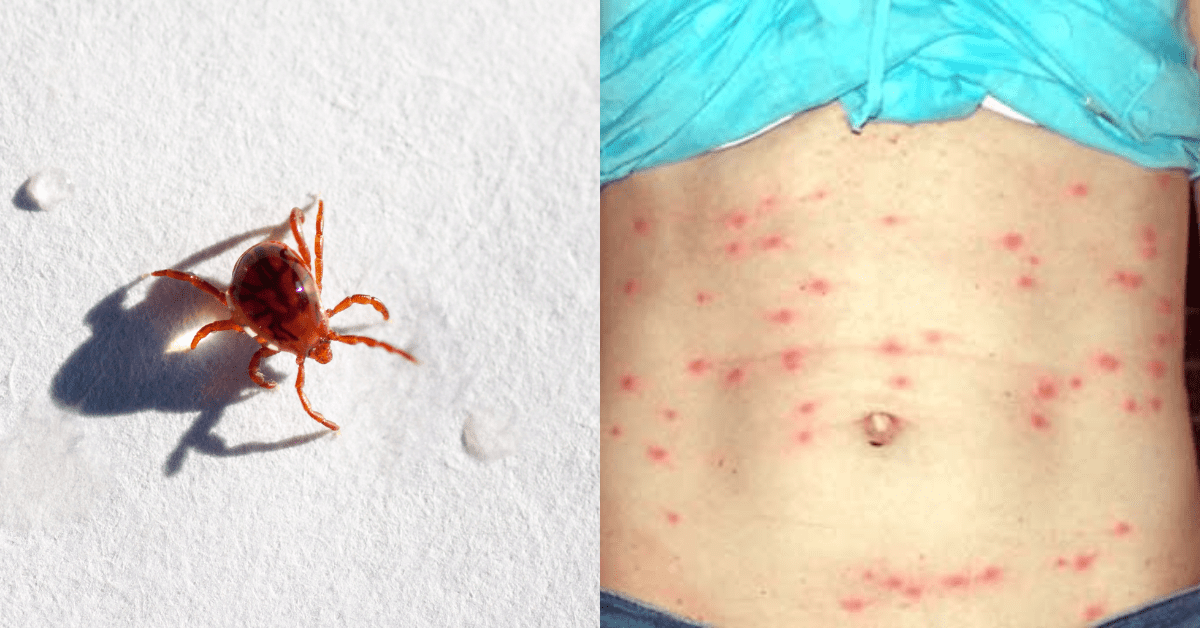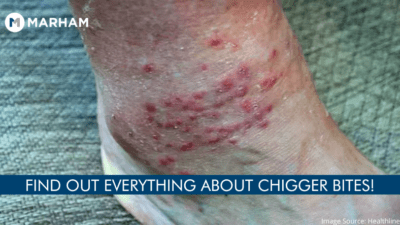Chiggers are tiny mites that live in woody areas. Chiggers are more active during summer and get into your clothes. Chigger bites cause irritation and stinging, particularly in areas like ankles, lower legs, waist, and groin. These bugs are invisible to the naked eye and fall off when you scratch.
Check out everything you need to know about chigger bites, from their images to their symptoms, prevention, and treatments.
What are Chigger Bites?
Chigger is the common name for mites of the Trombiculid family. When the larvae of these mites bite it can lead to pruritus and irritation, a condition known as trombiculiasis or trombiculosis.
Chiggers, red bugs, and harvest mites are some of the names given to these larvae. Chiggers grow in low grasses and bushes all year in tropical, humid regions or in nontropical areas during the summer and fall.
Chigger bites are typically mild, although they can occasionally transfer illness or cause a bacterial superinfection.
Chigger Bites vs Poison Ivy:
The difference between chigger bites and poison ivy is that chiggers are mites that attach to your skin to bite, whereas poison ivy is a poisonous plant.
Chigger bites are clusters of uncomfortable, pink pimples that can get red and crusty when rubbed. They often heal on their own after one to two weeks.
On the other hand, each poison ivy leaf has three smaller leaflets. It may produce red, inflamed skin, blisters, and intense itching within hours of contact with any portion of the plant. Poison ivy rash normally goes away on its own after a few weeks.
Chigger Bites vs Flea Bites:
Chiggers and fleas are both bugs, but fleas can be seen by the human eye. They have small, flat bodies and rigid shells and lack wings. Unlike chiggers, fleas can be found in your house, especially if you have pets.
Fleabites have a unique appearance. They appear as little red bumps in groups of three or four or in a straight line. Fleabites can also induce allergic responses in pets and anemia from blood loss.
Chigger Bites Pictures:
Here are some pictures of chigger bites to give you an idea of their appearance. The chigger bite picture is originally captured after magnification under a microscope, as these bugs are not visible to the naked eye.


What are some Chigger Bites Symptoms?
Chigger bites appear as itchy red lumps that resemble pimples, blisters, or tiny hives. They are commonly found at the waist, ankles, or warm skin folds.
Chigger bites can get larger and itchier with time and frequently occur in clusters. Some chigger bite symptoms are:
- Splotchy line of red patches or pimples (as shown in the chigger bite picture above)
- Most bites are present where your clothes are in contact with the body
- severe itching
Click here to consult online with a Skin Specialist if you have any of these symptoms.
How to Prevent Chigger Bites?
Chiggers are most commonly found in the spring, summer, and fall. Chigger bites on humans can be prevented using the following methods:
- Avoid Long Grass: Avoid brushing up against foliage in forested regions that may be infected with chiggers.
- Be cautious while hiking: Hike in the center of paths rather than along the sides.
- Wear Full-Covering Clothes: Wear long-sleeved shirts and slacks that can be tucked into socks or shoes.
- Use Insect Repellant: Apply insect or tick repellant on the tops of your shoes, shirt collar, cuffs, and waistline.
- Shower after returning from the outdoors: Shower as soon as you enter the house.
- Wash your clothes: Warm water should be used to wash your garments.
Also, read about the Signs and Symptoms of Dengue Fever
What is the Treatment for Chigger Bites?
The treatment for chigger bites focuses on relief from itching, redness, or swelling. Chiggers do not penetrate your skin and separate after biting, so therapy to eliminate the mites is unnecessary.
Some treatment options are chigger bites include the following:
- Using creams or lotions on the skin
- Taking antihistamines such as diphenhydramine
- Using an anti-parasite medicine
- Using a cold compress
- Regularly clean the afflicted skin area with soap and water
The Bottom Line
Chigger bites usually improve independently but can cause extreme itching and swelling. If extreme itching leads to an infection in which the skin gets red, swells, or exudes pus, then you might need the help of a doctor.
A Skin Specialist can help you find the best treatment for chigger bites. Click here to book an appointment or video consultation with the Best Skin Specialists Online.
FAQs
1. What do chigger bites look like?
Chigger bites appear as itchy red lumps that resemble pimples, blisters, or tiny hives. They are commonly found at the waist, ankles, or warm skin folds. These bites may also lead to a bacterial infection.
2. How long do chigger bites last on your body?
Chigger bites normally go away independently after a few days, although they might remain for up to two weeks. But, in the case of bacterial infection, it can take longer for chigger bites to get better.
3. How do you get rid of chigger bites?
The easiest technique to remove chiggers is to lather yourself with soap and often rinse with warm water. Itching can be reduced by removing the infected clothes. You may also use over-the-counter anti-itch drugs such as pramoxine or hydrocortisone.

